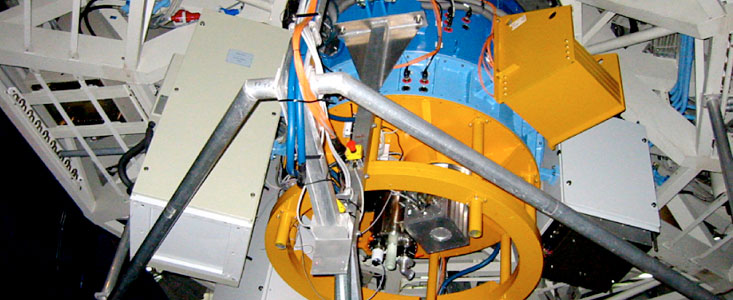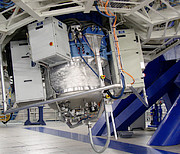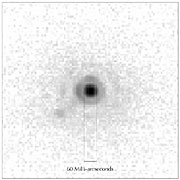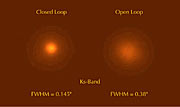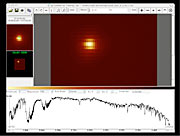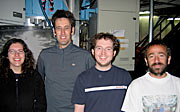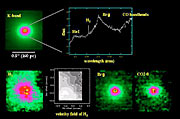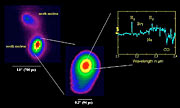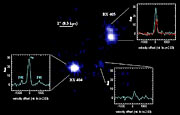Comunicato Stampa
SINFONI Opens with Upbeat Chords
First Observations with New VLT Instrument Hold Great Promise Summary
24 Agosto 2004
The European Southern Observatory, the Max-Planck-Institute for Extraterrestrial Physics (Garching, Germany) and the Nederlandse Onderzoekschool Voor Astronomie (Leiden, The Netherlands), and with them all European astronomers, are celebrating the successful accomplishment of "First Light" for the Adaptive Optics (AO) assisted SINFONI ("Spectrograph for INtegral Field Observation in the Near-Infrared") instrument, just installed on ESO's Very Large Telescope at the Paranal Observatory (Chile). This is the first facility of its type ever installed on an 8-m class telescope, now providing exceptional observing capabilities for the imaging and spectroscopic studies of very complex sky regions, e.g. stellar nurseries and black-hole environments, also in distant galaxies. Following smooth assembly at the 8.2-m VLT Yepun telescope of SINFONI's two parts, the Adaptive Optics Module that feeds the SPIFFI spectrograph, the "First Light" spectrum of a bright star was recorded with SINFONI in the early evening of July 9, 2004. The following thirteen nights served to evaluate the performance of the new instrument and to explore its capabilities by test observations on a selection of exciting astronomical targets. They included the Galactic Centre region, already imaged with the NACO AO-instrument on the same telescope. Unprecedented high-angular resolution spectra and images were obtained of stars in the immediate vicinity of the massive central black hole. During the night of July 15 - 16, SINFONI recorded a flare from this black hole in great detail. Other interesting objects observed during this period include galaxies with active nuclei (e.g., the Circinus Galaxy and NGC 7469), a merging galaxy system (NGC 6240) and a young starforming galaxy pair at redshift 2 (BX 404/405). These first results were greeted with enthusiasm by the team of astronomers and engineers [2] from the consortium of German and Dutch Institutes and ESO who have worked on the development of SINFONI for nearly 7 years. The work on SINFONI at Paranal included successful commissioning in June 2004 of the Adaptive Optics Module built by ESO, during which exceptional test images were obtained of the main-belt asteroid (22) Kalliope and its moon. Moreover, the ability was demonstrated to correct the atmospheric turbulence by means of even very faint "guide" objects (magnitude 17.5), crucial for the observation of astronomical objects in many parts of the sky. SPIFFI - SPectrometer for Infrared Faint Field Imaging - was developed at the Max Planck Institute for Extraterrestrische Physik (MPE) in Garching (Germany), in a collaboration with the Nederlandse Onderzoekschool Voor Astronomie (NOVA) in Leiden and the Netherlands Foundation for Research in Astronomy (ASTRON), and ESO.
SINFONI: A powerful and complex instrument
A new and very powerful astronomical instrument, a world-leader in its field, has been installed on the Very Large Telescope at the Paranal Observatory (Chile), cf. eso0426a, eso0426b. Known as SINFONI ("Spectrograph for INtegral Field Observation in the Near-Infrared"), it was mounted in two steps at the Cassegrain focus of the 8.2-m VLT YEPUN telescope. First Light of the completed instrument was achieved on July 9, 2004 and various test observations during the subsequent commissioning phase were carried out with great success.
SINFONI has two parts, the Near Infrared Integral Field Spectrograph, also known as SPIFFI (SPectrometer for Infrared Faint Field Imaging), and the Adaptive Optics Module. SPIFFI was developed at the Max Planck Institute for Extraterrestrische Physik (MPE) (Garching, Germany), in a collaboration with the Nederlandse Onderzoekschool Voor Astronomie (NOVA) in Leiden, the Netherlands Foundation for Research in Astronomy (ASTRON) (The Netherlands), and the European Southern Observatory (ESO) (Garching, Germany). The Adaptive Optics (AO) Module was developed by ESO.
Once fully commissioned, SINFONI will provide adaptive-optics assisted Integral Field Spectroscopy in the near-infrared 1.1 - 2.45 µm waveband. This advanced technique provides simultaneous spectra of numerous adjacent regions in a small sky field, e.g., of an interstellar nebula, the stars in a dense stellar cluster or a galaxy. Astronomers refer to these data as "3D-spectra" or "data cubes" (i.e., one spectrum for each small area in the two-dimensional sky field), cf. Appendix A.
The SINFONI Adaptive Optics Module is based on a 60-element curvature system, similar to the Multi Application Curvature Adaptive Optics devices (MACAO), developed by the ESO Adaptive Optics Department and of which three have already been installed at the VLT; the last one in August 2004.
Provided a sufficiently bright reference source ("guide star") is available within 60 arcsec of the observed field, the SINFONI AO module will ultimately offer diffraction-limited images (resolution 0.050 arcsec) at a wavelength of 2 µm. At the centre of the field, partial correction can be performed with guide stars as faint as magnitude 17.5. In about 6-months' time, it will benefit from a sodium Laser Guide Star, achieving a much better sky coverage than what is now possible.
SPIFFI is a fully cryogenic near-infrared integral field spectrograph allowing observers to obtain simultaneously spectra of 2048 pixels within a 64 x 32 pixel field-of-view. In conjunction with the AO Module, it performs spectroscopy with slit-width sampling at the diffraction limit of an 8-m class telescope. For observations of very faint, extended celestial objects, the spatial resolution can be degraded so that both sensitivity and field-of-view are increased. SPIFFI works in the near-infrared wavelength range (1.1 - 2.45 µm) with a moderate spectral resolving power (R = 1500 to 4500). More information about the way SPIFFI functions will be found in Appendix A.
"First Light with SINFONI's Adaptive Optics Module
Because of the complexity of SINFONI, with its two modules, it was decided to perform the installation on the 8.2-m VLT Yepun telescope in two steps.
The Adaptive Optics module was completely dismounted at ESO-Garching (Germany) and the corresponding 6 tons of equipment was air-freighted from Frankfurt to Santiago de Chile. The subsequent transport by road arrived at the Paranal Observatory on April 21, 2004. After 6 weeks of reintegration and testing in the Integration Hall, the AO Module was mounted on Yepun on May 30 - 31, together with a high-angular-resolution near-infrared Test Camera, cf. eso0426a.
Technical "First-Light" with this system was achieved around midnight on May 31st by observing a 11-magnitude star, cf. eso0426c, reaching right away the theoretical diffraction limit of the 8.2-m telescope (0.06 arcsec) at this wavelength (2.2 µm). Following this early success, the ESO AO team continued the full on-sky tuning and testing of the AO Module until June 8, setting in particular a new world record by reaching a limiting guide-star magnitude of 17.5, two-and-a-half magnitudes (a factor of 10) fainter than ever achieved with any telescope! The ability to perform AO corrections on very faint guide objects is essential for SINFONI in order to observe very faint extragalactic objects.
During this commissioning period, test observations were performed of the binary asteroid (22) Kalliope and its moon Linus. They were made by the ESO AO team and served to demonstrate the high performance of this ESO-built Adaptive Optics (AO) system at near-infrared wavelengths. More information about these observations, including a movie of the orbital motion of Linus is available in Appendix B.
"First Light" with SINFONI
The fully integrated SPIFFI module was air-freighted from Frankfurt to Santiago de Chile and arrived at Paranal on June 5, 2004. The subsequent cool-down to -195 °C was done and an extensive test programme was carried through during the next two weeks. Meanwhile, the AO Module was removed from the telescope and the "wedding" with SPIFFI was celebrated on June 20 in the Paranal Integration Hall. All went well and the first AO-corrected test spectra were obtained immediately thereafter. The extensive tests of SINFONI continued at this site until July 7, 2004, when the instrument was declared fit for work at the telescope. The installation at the 8.2-m VLT Yepun telescope was then accomplished on July 8 - 9.
"First Light" was achieved in the early evening of July 9, 2004, only 30 min after the telescope enclosure was opened. At 19:30 local time, SINFONI recorded the first AO-corrected "data cube" with spectra of HD 130163. This 7th-magnitude star was observed in the near-infrared H-band with a moderate seeing of 0.8 arcsec.
Test Observations with SINFONI
Until July 22, test observations on a number of celestial objects were performed in order to tune the instrument, to evaluate the performance and to demonstrate its astronomical capabilities. In particular, spectra were obtained of various highly interesting celestial objects and sky regions. Details about these observations (and some images obtained with the AO Module alone) are available in the Appendices to this Press Release:
- a video of the motion of the moon Linus around the main-belt asteroid (22) Kalliope, providing the best view of this binary system obtained so far (Appendix B);
- images and first-ever detailed spectra of many of the stars that move near the massive black hole at the Galactic Centre, with crucial information on the nature of the individual stars and their motions (Appendix C);
- images and spectra of the heavily dust-obscured, active centre of the Circinus galaxy, one of the closest active galaxies, showing ordered rotation in this area and distinct broad and narrow components of the spectral line of Ca7+-ions (Appendix D);
- images and spectra of the less obscured central area of NGC 7469, a more distant active galaxy, with spectral lines of molecular hydrogen and carbon monoxide showing a very different distribution of these species (Appendix E);
- images and spectra of the Infrared Luminous Galaxy (ULIRG) NGC 6240, a typical galaxy merger, displaying important differences between the two nuclei (Appendix F), and
- images and spectra of the young starforming galaxies BX 404/405, casting more light on the formation of disks in spiral galaxies (Appendix G)
The SINFONI Teams
been greeted with enthusiasm, in particular by the team of astronomers and engineers from the consortium of German and Dutch institutes and ESO who worked on the development of SINFONI for nearly 7 years.
Some of the members of the Commissioning Teams are depicted in eso0426h; in addition to the SPIFFI team members present, Walter Bornemann, Reinhard Genzel, Hans Gemperlein, Stefan Huber have also been working on the reintegration/commissioning in Paranal.
Note
[1] This press release is issued in coordination between ESO, the Max-Planck-Institute for Extraterrestrial Physics (MPE) in Garching, Germany, and the Nederlandse Onderzoekschool Voor Astronomie in Leiden, The Netherlands. A German version is available at http://www.mpg.de/bilderBerichteDokumente/dokumentation/pressemitteilungen/2004/pressemitteilung20040824/index.html and a Dutch version at http://www.astronomie.nl/#!/actueel/nieuws-archief/_detail/gli/sinfoni-geeft-very-large-telescope-3d-zicht/.
[2] The SINFONI team consists of Roberto Abuter, Andrew Baker, Walter Bornemann, Ric Davies, Frank Eisenhauer (SPIFFI Principal Investigator), Hans Gemperlein, Reinhard Genzel (MPE Director), Andrea Gilbert, Armin Goldbrunner, Matthew Horrobin, Stefan Huber, Christof Iserlohe, Matthew Lehnert, Werner Lieb, Dieter Lutz, Nicole Nesvadba, Claudia Röhrle, Jürgen Schreiber, Linda Tacconi, Matthias Tecza, Niranjan Thatte, Harald Weisz (Max-Planck-Institut für Extraterrestrische Physik, Garching, Germany), Anthony Brown, Paul van der Werf (NOVA, Leiden, The Netherlands), Eddy Elswijk, Johan Pragt, Jan Kragt, Gabby Kroes, Ton Schoenmaker, Rik ter Horst (ASTRON, Dwingeloo, The Netherlands), Henri Bonnet (SINFONI Project Manager), Roberto Castillo, Ralf Conzelmann, Romuald Damster, Bernard Delabre, Christophe Dupuy, Robert Donaldson, Christophe Dumas, Enrico Fedrigo, Gert Finger, Gordon Gillet, Norbert Hubin (Head of Adaptive Optics Dept.), Andreas Kaufer, Franz Koch, Johann Kolb, Andrea Modigliani, Guy Monnet (Head of Telescope Systems Division), Chris Lidman, Jochen Liske, Jean Louis Lizon, Markus Kissler-Patig (SINFONI Instrument Scientist), Jerome Paufique, Juha Reunanen, Silvio Rossi, Riccardo Schmutzer, Armin Silber, Stefan Ströbele (SINFONI System Engineer), Thomas Szeifert, Sebastien Tordo, Leander Mehrgan, Joerg Stegmeier, Reinhold Dorn (European Southern Observatory).
Ulteriori Informazioni
Appendix A: Integral Field Spectroscopy as a Powerful Discovery Tool
How does SINFONI work? What is Integral Field Spectroscopy (IFS)?
The idea of IFS is to obtain a spectrum of each defined spatial element ("spaxel") in the field-of-view. Several techniques to do this are available - in SINFONI, the slicer principle is applied. This involves (ESO Press Photo eso0426) that
- the two-dimensional field-of-view is cut into slices, the so-called slitlets (short slits in contrast to normal long-slit spectroscopy),
- the slitlets are then arranged next to each other to form a pseudo-long-slit,
- a grating is used to disperse the light, and
- the photons are detected with a Near-InfraRed detector.
Following data reduction, the set of generated spectra can be re-arranged in the computer to form a 3-dimensional "data cube" of two spatial, and one wavelength dimension. Thus the term "3D-Spectroscopy" is sometimes used for IFS.
Appendix B: Linus' orbital motion around Kalliope
Video eso0426a shows the 3.6-day orbital motion of the satellite (moon) Linus around the main-belt asteroid (22) Kalliope.
Kalliope orbits the Sun between Mars and Jupiter; it measures about 180 km across and the diameter of its moon is 50 km. This system was observed with the SINFONI AO Module for short periods over four consecutive nights.
Linus moves around Kalliope in a circular orbit, at a distance of 1000 km and with a direction of motion similar to the rotation of Kalliope (prograde rotation); the orbital plane of the moon was seen under a 60°-angle with respect to the line-of-sight. The unobserved parts of this orbit are indicated by a dotted line.
A hypothetical observer on the surface of Kalliope would live in a strange world: the days would be 14 hours long, and the sky would be filled by a moon five times bigger than our own!
The brightness changes of the Linus images is due to variations in the sky conditions at the time of the observations. Rapid changes in the atmosphere result in variations in the sharpness of the corrected images. During the first two nights, seeing conditions were very good, but less so during the last two nights; this can be seen as a slight loss of sharpness of the corresponding satellite images.
The discovery of this asteroid satellite, named Linus after the son of Kalliope, the Greek muse of heroic poetry, was first reported in September 2001 by a group of astronomers using the Canadian-France-Hawaii telescope on Mauna Kea (Hawaii, USA). Although previously believed to consist of metal-rich material, the discovery of Linus allowed the scientists to determine the mean density of Kalliope as ~ 2 g/cm3, a rather low value and not consistent with a metal-rich object. Kalliope is now believed to be a "rubble-pile" stony asteroid. Its porous interior is due to a catastrophic collision with another, smaller asteroid early in its history and which also gave birth to Linus.
Other references related to Kalliope can be found in the International Astronomical Union Circular (IAUC) 7703 (2001) and a research article "A low density M-type asteroid in the main-belt" by Margot and Brown (Science 300, 193, 2003).
Appendix C: Stars at the Galactic Centre and a Flare from the Black Hole
The Milky Way Centre is a unique laboratory for studying physical processes that are thought to be common in galactic nuclei. The Galactic Centre is not only the best studied case of a supermassive black hole, but the region also hosts the largest population of high-mass stars in the Galaxy. Diffraction-limited near-IR integral field spectroscopy offers a unique opportunity for exploring in detail the physical phenomena responsible for the active phases of this supermassive black hole, and for studying the dynamics and evolution of the star cluster in its immediate vicinity.
With the new SINFONI observations, some of which are displayed in ESO Press Photo eso0426, it was possible to obtain for the first time very detailed near-infrared spectra of several young and massive stars orbiting the black hole at the centre of our galaxy. The presence of spectral signatures from ionised hydrogen (the Bracket-gamma line) and Helium clearly classify these stars as young, massive early-type stars. They are comparatively short-lived, and the large fraction of such stars in the immediate vicinity of a supermassive black hole is a mystery.
The first SINFONI observations of the stellar populations in the innermost Galactic Centre region will now help to explain the origin and formation process of those stars. Moreover, the observed spectral features allow measuring their motions along the line-of-sight (the "radial velocities"). Combining them with the motions in the sky (the "proper motions") obtained from previous observations with the NACO instrument, it is now possible to determine all orbital parameters for the "S"-stars. This in turn makes it possible to measure directly the mass and the distance of the supermassive black hole at the centre of our galaxy.
But not only this! Even more exciting, it became possible to register for the first time the infrared spectrum of a flare from the Galactic Centre black hole. From the earlier imaging observations, it is known that such outbursts occur approximately once every 4 hours, giving us a uniquely detailed glimpse of a black hole feeding on left-over gas in its close surroundings. It is only the innovative technique of SINFONI - providing spectra for every pixel in a diffraction-limited image - that made it possible to capture the infrared spectrum of such a flare. Such spectra from SINFONI will soon allow to understand better the physics and mechanisms involved in the flare emission.
Appendix D: The Active Circinus Galaxy
At a distance of about 13 million light-years, the Circinus galaxy is one of the nearest galaxies with a very active black hole at the centre. It is seen behind a highly obscured sky field, only 3° from the Milky Way main plane in the southern constellation of this name ("The Pair of Compasses"). Using the nucleus of this galaxy to guide the AO Module, SINFONI was able to zoom in on the central arcsec region - only 60 light-years across - and to map the immediate environment of the black hole at the centre, cf. ESO Press Photo eso0426.
The K-band (wavelength 2 µm) image (insert at the upper left) displays a very compact structure; the emission recorded at this wavelength comes from hot dust heated by radiation from the accretion disc around the black hole. However, as may be seen in the two inserts below, both the emission from ionized hydrogen (the Brackett-gamma line) and molecular hydrogen (H2) are more extended, up to about 30 light-years. As these spectral lines (cf. the spectral tracing at the upper right) are quite narrow and show ordered rotation up to ±40km/s, it is likely that they arise from star formation in a disk around the central black hole.
A surprise from the SINFONI observations is that the spectral line of Ca7+-ions (seven times ionised Calcium atoms, or [Ca VIII], which are produced by the ionizing effect of very energetic ultraviolet radiation) in this area appears to have distinct broad and narrow components (images at the lower right). The broad component is centred on the region around the black hole, and probably arises in the so-called "Broad-Line Region". The narrow component is displaced to the north-west and most likely indicates a region where there is a direct line-of-sight from the black hole to some gas clouds.
Appendix E: The Active Nucleus in NGC 7469
The galaxy NGC 7469 (seen north of the celestial equator in the constellation Pegasus) also hosts an active galactic nucleus, but contrary to the Circinus galaxy, it is relatively unobscured. Since NGC 7469 is at a much larger distance, about 225 million light-years, the 0.15 arcsec resolution achieved by SINFONI here corresponds to about 165 light-years.
The K-band image (ESO Press Photo eso0426) shows the bright, compact nucleus of this galaxy, and the spectrum displays very broad lines of ionized hydrogen (the Brackett-gamma line) and helium. This emission arises in the "Broad-Line" region which is still unresolved, as shown by the Brackett-gamma image.
On the other hand, the molecular hydrogen extends up to 650 light-years from the centre and shows an ordered rotation. In contrast, the image obtained in the light of CO-molecules - which directly traces late-type stars typical for starbursts - appears very compact. These results confirm those obtained by means of earlier AO observations, but with the new SINFONI data corresponding to various spectral lines, the detailed, two-dimensional structure and motions close to the central black hole are now clearly revealed for the first time.
Appendix F: The Galaxy Merger NGC 6240
The infrared-luminous galaxy NGC 6240 in the constellation Ophiuchus (The Serpent-holder) is in many ways the prototype of a gas-rich, infrared-(ultra-)luminous galaxy merger.
This system has two rapidly rotating, massive bulges/nuclei at a projected angular separation of 1.6 arcsec. Each of them contains a powerful starburst region and a luminous, highly obscured, X-ray-emitting supermassive black hole. As such, NGC 6240 is probably a nearby example of dust and gas-rich galaxy merger systems seen at larger distances.
NGC6240 is also the most luminous, nearby source of molecular hydrogen emission. It was observed in the K-band (wavelength 2 µm), using a faint star at a distance of about 35 arcsec as the AO "guide" star. The starburst activity is traced by the ionized gas and occurs mostly at the two nuclei in regions measuring around 650 light-years across. The distribution of the molecular gas is very different. It follows a complex spatial and dynamical pattern with several extended streamers.
The high-resolution SINFONI data now makes it possible - for the first time - to investigate the distribution and motion of the molecular gas, as well as the stellar population in this galaxy with a "resolution" of about 80 light-years.
Appendix G: Motions in the Young Star-Forming Galaxies BX 404/405
SINFONI Observations of the Distant Galaxy Pair BX 404/405"How and when did the discs in spiral galaxies like the Milky Way form? This is one of the longest-standing puzzles in modern cosmology.
Two general models presently describe how disk galaxies may form. One is based on a scenario in which there is a gentle collapse of gas clouds that collide and lose momentum. They sink towards a "centre", thereby producing a disc of gas in which stars are formed. The other implies that galaxies grow through repeated mergers of smaller gas-rich galaxies. Together they first produce a spherical mass distribution at the centre and any remaining gas then settles into a disk.
Recent studies of stars in the Milky Way system and nearby spiral galaxies suggest that the discs now present in these systems formed about 10,000 million years ago. This corresponds to the epoch when we observe galaxies at redshifts of about 1.5 - 2.5. Interestingly, studies of galaxies at these distances seem consistent with current ideas about when disks may have formed, and there is some evidence that most of the mass in the galaxies was also assembled at that time.
In any case, the most direct way to verify such a connection is to observe galaxies at redshifts 1.5-2.5, in order to elucidate whether their observed properties are consistent with velocity patterns of rotating disks of gas and stars. This would be visible as a "velocity shear", i.e., a significant difference in velocity of neigbouring regions. In addition, such observations may provide a good test of the above mentioned hypotheses for how discs may have formed.
Various groups of astrophysicists in the US and Europe have developed observational selection criteria which may be used to identify galaxies with properties similar to those expected for young disc galaxies. Observations with SINFONI was made of one of these objects, the galaxy pair BX 404/405 discovered by a group of astronomers at Caltech (USA).
For BX 405, clear signs were found of a "velocity shear" like that expected for rotation of a forming disk, but the other object does not show this. It may thus be that the properties of star-forming galaxies at this epoch are quite complex and that only some of them have young disks.
Contatti
Frank Eisenhauer
Max-Planck-Institut für Extraterrestrische Physik (MPE)
Garching, Germany
Tel.: +49-89-30000-3563
E-mail: eisenhau@mpe.mpg.de
Paul van der Werf
Leiden Observatory
Leiden, Netherlands
Tel.: +31-71-5275883
E-mail: pvdwerf@strw.leidenuniv.nl
Henri Bonnet
ESO
Garching, Germany
E-mail: hbonnet@eso.org
Reinhard Genzel
Max-Planck-Institut für Extraterrestrische Physik (MPE)
Garching, Germany
Tel.: +49-89-30000-3280
Norbert Hubin
ESO
Garching, Germany
E-mail: nhubin@eso.org
Sul Comunicato Stampa
| Comunicato Stampa N": | eso0426 |
| Legacy ID: | PR 21/04 |
| Nome: | 22 Kalliope, Adaptive Optics, BX 404/405, Circinus Galaxy, Galactic Centre, HD 130163 , Instrumentation, Linus, NGC 6240, NGC 7469, Very Large Telescope |
| Tipo: | Unspecified : Technology : Observatory : Instrument |
| Facility: | Very Large Telescope |
| Instruments: | NACO, SINFONI |
Our use of Cookies
We use cookies that are essential for accessing our websites and using our services. We also use cookies to analyse, measure and improve our websites’ performance, to enable content sharing via social media and to display media content hosted on third-party platforms.
ESO Cookies Policy
The European Organisation for Astronomical Research in the Southern Hemisphere (ESO) is the pre-eminent intergovernmental science and technology organisation in astronomy. It carries out an ambitious programme focused on the design, construction and operation of powerful ground-based observing facilities for astronomy.
This Cookies Policy is intended to provide clarity by outlining the cookies used on the ESO public websites, their functions, the options you have for controlling them, and the ways you can contact us for additional details.
What are cookies?
Cookies are small pieces of data stored on your device by websites you visit. They serve various purposes, such as remembering login credentials and preferences and enhance your browsing experience.
Categories of cookies we use
Essential cookies (always active): These cookies are strictly necessary for the proper functioning of our website. Without these cookies, the website cannot operate correctly, and certain services, such as logging in or accessing secure areas, may not be available; because they are essential for the website’s operation, they cannot be disabled.
Functional Cookies: These cookies enhance your browsing experience by enabling additional features and personalization, such as remembering your preferences and settings. While not strictly necessary for the website to function, they improve usability and convenience; these cookies are only placed if you provide your consent.
Analytics cookies: These cookies collect information about how visitors interact with our website, such as which pages are visited most often and how users navigate the site. This data helps us improve website performance, optimize content, and enhance the user experience; these cookies are only placed if you provide your consent. We use the following analytics cookies.
Matomo Cookies:
This website uses Matomo (formerly Piwik), an open source software which enables the statistical analysis of website visits. Matomo uses cookies (text files) which are saved on your computer and which allow us to analyze how you use our website. The website user information generated by the cookies will only be saved on the servers of our IT Department. We use this information to analyze www.eso.org visits and to prepare reports on website activities. These data will not be disclosed to third parties.
On behalf of ESO, Matomo will use this information for the purpose of evaluating your use of the website, compiling reports on website activity and providing other services relating to website activity and internet usage.
Matomo cookies settings:
Additional Third-party cookies on ESO websites: some of our pages display content from external providers, e.g. YouTube.
Such third-party services are outside of ESO control and may, at any time, change their terms of service, use of cookies, etc.
YouTube: Some videos on the ESO website are embedded from ESO’s official YouTube channel. We have enabled YouTube’s privacy-enhanced mode, meaning that no cookies are set unless the user actively clicks on the video to play it. Additionally, in this mode, YouTube does not store any personally identifiable cookie data for embedded video playbacks. For more details, please refer to YouTube’s embedding videos information page.
Cookies can also be classified based on the following elements.
Regarding the domain, there are:
- First-party cookies, set by the website you are currently visiting. They are stored by the same domain that you are browsing and are used to enhance your experience on that site;
- Third-party cookies, set by a domain other than the one you are currently visiting.
As for their duration, cookies can be:
- Browser-session cookies, which are deleted when the user closes the browser;
- Stored cookies, which stay on the user's device for a predetermined period of time.
How to manage cookies
Cookie settings: You can modify your cookie choices for the ESO webpages at any time by clicking on the link Cookie settings at the bottom of any page.
In your browser: If you wish to delete cookies or instruct your browser to delete or block cookies by default, please visit the help pages of your browser:
Please be aware that if you delete or decline cookies, certain functionalities of our website may be not be available and your browsing experience may be affected.
You can set most browsers to prevent any cookies being placed on your device, but you may then have to manually adjust some preferences every time you visit a site/page. And some services and functionalities may not work properly at all (e.g. profile logging-in, shop check out).
Updates to the ESO Cookies Policy
The ESO Cookies Policy may be subject to future updates, which will be made available on this page.
Additional information
For any queries related to cookies, please contact: pdprATesoDOTorg.
As ESO public webpages are managed by our Department of Communication, your questions will be dealt with the support of the said Department.
